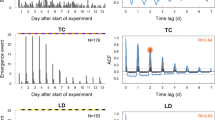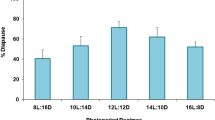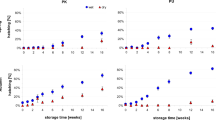Abstract
THE life-history of this carpet beetle under outdoor conditions in southern England is as follows. Adults emerge in June and July and may be found on many species of creamy-white flowers, notably cultivated Spiraea spp. and Heracleum sphondylium L. (hogweed). One of the main oviposition sites is dry birds' nest material found in the attics of buildings. Eggs hatch in about five weeks, but larvæ may require two years for complete development. Pupation occurs in early May, and lasts about a month; after a further week of inactivity the active adults emerge. When mating occurs immediately, eggs are laid from about one week onwards for at least a month. Adults die about the end of July. Experiments on the development of larvæ under outdoor conditions showed a clear annual rhythm of activity, namely, a rapid rate of moulting during the summer (May–August) and rest during the winter.
This is a preview of subscription content, access via your institution
Access options
Subscribe to this journal
Receive 51 print issues and online access
$199.00 per year
only $3.90 per issue
Buy this article
- Purchase on Springer Link
- Instant access to full article PDF
Prices may be subject to local taxes which are calculated during checkout
Similar content being viewed by others
References
Blake, G. M., Bull. Ent. Res. (in the press).
Author information
Authors and Affiliations
Rights and permissions
About this article
Cite this article
BLAKE, G. Control of Diapause by an ‘Internal Clock’ in Anthrenus verbasci (L.) (Col., Dermestidae). Nature 183, 126–127 (1959). https://doi.org/10.1038/183126a0
Issue Date:
DOI: https://doi.org/10.1038/183126a0
This article is cited by
-
Effects of temperature on the development and circannual control of pupation in the carpenter moth, Cossus insularis (Lepidoptera: Cossidae), reared on an artificial diet
Applied Entomology and Zoology (2017)
-
Responsiveness to photoperiodic changes in the circannual rhythm of the varied carpet beetle, Anthrenus verbasci
Journal of Comparative Physiology A (2009)
-
Phase resetting and phase singularity of an insect circannual oscillator
Journal of Comparative Physiology A (2007)
-
A phase response curve for circannual rhythm in the varied carpet beetle Anthrenus verbasci
Journal of Comparative Physiology A (2005)
-
Temperature compensation of circasemilunar timing in the intertidal insectClunio
Journal of Comparative Physiology A (1988)
Comments
By submitting a comment you agree to abide by our Terms and Community Guidelines. If you find something abusive or that does not comply with our terms or guidelines please flag it as inappropriate.



